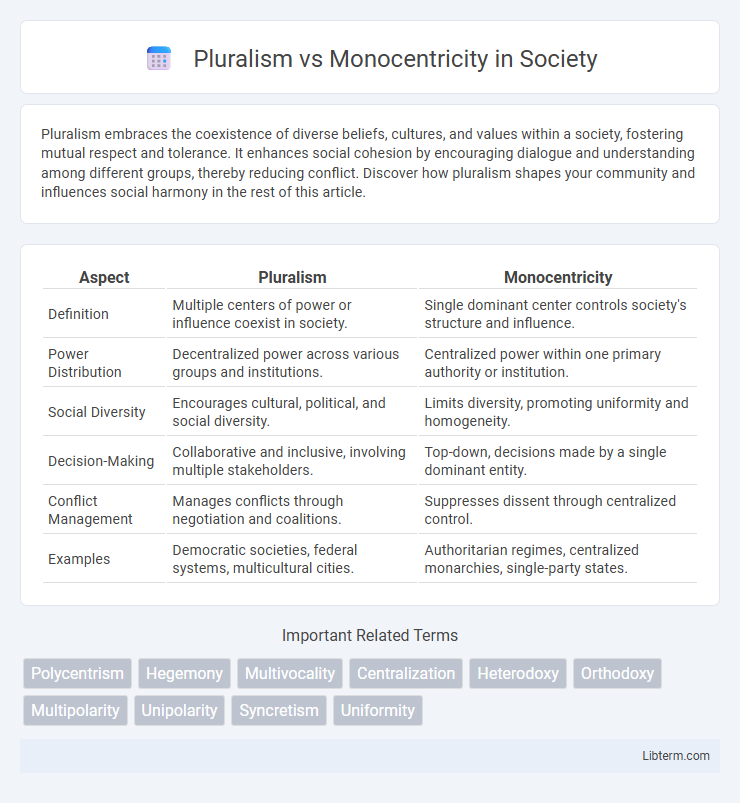Pluralism embraces the coexistence of diverse beliefs, cultures, and values within a society, fostering mutual respect and tolerance. It enhances social cohesion by encouraging dialogue and understanding among different groups, thereby reducing conflict. Discover how pluralism shapes your community and influences social harmony in the rest of this article.
Table of Comparison
| Aspect | Pluralism | Monocentricity |
|---|---|---|
| Definition | Multiple centers of power or influence coexist in society. | Single dominant center controls society's structure and influence. |
| Power Distribution | Decentralized power across various groups and institutions. | Centralized power within one primary authority or institution. |
| Social Diversity | Encourages cultural, political, and social diversity. | Limits diversity, promoting uniformity and homogeneity. |
| Decision-Making | Collaborative and inclusive, involving multiple stakeholders. | Top-down, decisions made by a single dominant entity. |
| Conflict Management | Manages conflicts through negotiation and coalitions. | Suppresses dissent through centralized control. |
| Examples | Democratic societies, federal systems, multicultural cities. | Authoritarian regimes, centralized monarchies, single-party states. |
Understanding Pluralism: A Multifaceted Approach
Pluralism emphasizes the coexistence of multiple centers of power and diverse perspectives within a system, fostering inclusivity and dynamic interaction among varied social, political, or cultural groups. This multifaceted approach challenges monocentricity, which concentrates authority or influence in a single entity, by promoting decentralized governance and plural values. Understanding pluralism involves recognizing its role in enhancing democratic processes, encouraging innovation, and reflecting complex societal realities through multiple, overlapping frameworks.
Defining Monocentricity: The Power of a Single Center
Monocentricity refers to a spatial or organizational structure where a single dominant center holds primary control or influence, concentrating political, economic, or social power within one core area. This centralization often leads to streamlined decision-making processes but can also create vulnerabilities due to over-reliance on one node. Understanding monocentricity is crucial for urban planners and governance experts when balancing efficiency with resilience in system design.
Historical Contexts: Pluralism and Monocentricity in Society
Pluralism in historical contexts reflects societies characterized by diverse power centers, social groups, and cultural influences, promoting inclusivity and multiple viewpoints. Monocentricity denotes periods or regimes dominated by a single authority or ideology, often centralizing political, economic, or cultural control. Understanding these dynamics reveals how power distribution shapes social cohesion, conflict, and governance structures throughout history.
Pluralism in Politics: Embracing Diversity of Voices
Pluralism in politics emphasizes the coexistence of multiple groups and interests within a society, ensuring diverse voices influence decision-making processes. This model fosters democratic resilience by promoting inclusion and preventing the concentration of power in a single entity. Embracing political pluralism enhances policy responsiveness and reflects the complex social fabric of modern democracies.
Monocentricity in Governance: Centralized Authority and Its Impact
Monocentricity in governance refers to a centralized authority structure where decision-making power is concentrated within a single, dominant entity or institution. This model streamlines policy implementation and ensures uniformity in regulations across jurisdictions, but it can reduce local autonomy and limit diverse stakeholder participation. Centralized governance often faces challenges related to bureaucratic inefficiencies and slower responsiveness to localized needs compared to pluralistic governance systems.
Cultural Implications: Diversity vs. Uniformity
Pluralism fosters cultural diversity by encouraging the coexistence of multiple values, beliefs, and traditions within a society, promoting inclusivity and mutual respect. Monocentricity promotes cultural uniformity, often leading to the dominance of a singular cultural narrative that can suppress minority identities and reduce social cohesion. Embracing pluralism supports multicultural policies, enhances social innovation, and strengthens democratic participation by reflecting varied cultural perspectives.
Social Cohesion: Strengths and Challenges of Each Model
Pluralism fosters social cohesion by encouraging diverse groups to coexist and engage in dialogue, promoting inclusivity and shared governance, which strengthens democratic resilience. Challenges in pluralist models include potential fragmentation and conflicting interests that may hinder unified social action. Monocentricity offers streamlined decision-making and clear authority, contributing to social stability, but risks marginalizing minority voices and suppressing diversity, potentially weakening long-term social cohesion.
Economic Perspectives: Decentralized Markets vs. Central Planning
Economic pluralism promotes decentralized markets, enabling diverse actors to respond swiftly to local demands and fostering innovation through competition. In contrast, monocentric economic planning relies on centralized control, aiming for efficiency by coordinating resources from a single authority but often confronting challenges like information bottlenecks and reduced entrepreneurial incentives. Empirical studies reveal that decentralized market systems typically achieve higher productivity growth and adaptability compared to centrally planned economies, highlighting the advantages of pluralistic structures.
Modern Applications: Pluralism and Monocentricity in Today’s World
Pluralism manifests in modern governance through decentralized political systems empowering local authorities, fostering diverse stakeholder participation, and encouraging multicultural integration within globalized societies. Monocentricity appears in corporate structures centered around a single headquarters or in urban planning focused on a dominant city core, which streamlines decision-making but can marginalize peripheral areas. The interplay between pluralism and monocentricity shapes economic development strategies, social policy frameworks, and technological innovation ecosystems worldwide.
The Future Debate: Toward a Balanced Societal Structure
The future debate between pluralism and monocentricity centers on creating a balanced societal structure that integrates diverse perspectives while maintaining cohesive governance. Pluralism advocates for multiple centers of power allowing for representation of varied interests, fostering innovation and resilience in social systems. Monocentricity emphasizes streamlined decision-making and uniform policy implementation, which can enhance stability but risks marginalizing minority voices.
Pluralism Infographic

 libterm.com
libterm.com